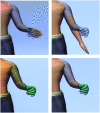A comparison of the real-time controllability of pattern recognition to conventional myoelectric control for discrete and simultaneous movements
- PMID: 24410948
- PMCID: PMC3895741
- DOI: 10.1186/1743-0003-11-5
A comparison of the real-time controllability of pattern recognition to conventional myoelectric control for discrete and simultaneous movements
Abstract
Myoelectric control has been used for decades to control powered upper limb prostheses. Conventional, amplitude-based control has been employed to control a single prosthesis degree of freedom (DOF) such as closing and opening of the hand. Within the last decade, new and advanced arm and hand prostheses have been constructed that are capable of actuating numerous DOFs. Pattern recognition control has been proposed to control a greater number of DOFs than conventional control, but has traditionally been limited to sequentially controlling DOFs one at a time. However, able-bodied individuals use multiple DOFs simultaneously, and it may be beneficial to provide amputees the ability to perform simultaneous movements. In this study, four amputees who had undergone targeted motor reinnervation (TMR) surgery with previous training using myoelectric prostheses were configured to use three control strategies: 1) conventional amplitude-based myoelectric control, 2) sequential (one-DOF) pattern recognition control, 3) simultaneous pattern recognition control. Simultaneous pattern recognition was enabled by having amputees train each simultaneous movement as a separate motion class. For tasks that required control over just one DOF, sequential pattern recognition based control performed the best with the lowest average completion times, completion rates and length error. For tasks that required control over 2 DOFs, the simultaneous pattern recognition controller performed the best with the lowest average completion times, completion rates and length error compared to the other control strategies. In the two strategies in which users could employ simultaneous movements (conventional and simultaneous pattern recognition), amputees chose to use simultaneous movements 78% of the time with simultaneous pattern recognition and 64% of the time with conventional control for tasks that required two DOF motions to reach the target. These results suggest that when amputees are given the ability to control multiple DOFs simultaneously, they choose to perform tasks that utilize multiple DOFs with simultaneous movements. Additionally, they were able to perform these tasks with higher performance (faster speed, lower length error and higher completion rates) without losing substantial performance in 1 DOF tasks.
Figures





References
-
- Medynski C, Rattray B. 2011 MyoElectric Controls/Powered Prosthetics Symposium. Fredericton, New Brunswick, Canada; 2011. Bebionic prosthetic design.
-
- Resnik L. Research update: VA study to optimize DEKA arm. J Rehabil Res Dev. 2010;47:ix-x. - PubMed
-
- Harris A, Katyal K, Para M, Thomas J. 2011 IEEE International Conference on Systems, Man, and Cybernetics. Anchorage, AK; 2011. Revolutionizing prosthetics software technology; pp. 2877–2884.
-
- Williams TW. In: Functional Restoration of Adults and Children with Upper Extremity Amputation. Meier RH, Atkins DJ, editor. New York, NY: Demos Medical Publishing; 2004. Control of powered upper extremity prostheses; pp. 207–224.
Publication types
MeSH terms
LinkOut - more resources
Full Text Sources
Other Literature Sources
Medical

